Leighton Buzzard Education 1812 to 1903
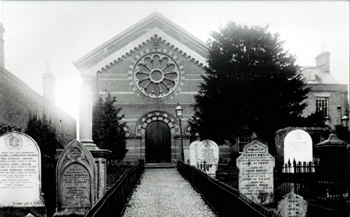
Lake Street Baptist Chapel about 1910 [Z50/72/167]
Early Nonconformist Schools
In 1812 the Society of Friends, who met, as they still do, in North Street, founded a Lancasterian School. The minister of the Baptist church in Lake Street, Thomas Wake, ran a school until his retirement in 1827; it is not known whether this continued. When a group of Baptists left Lake Street in they formed their own church in Grove Walk and from 1840 to 1847 were ministered to by James Cooper who also kept a school in North Street.
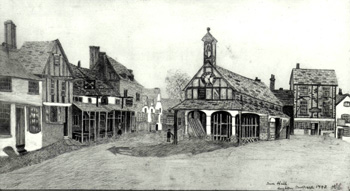
The Market House in 1798 [Z50/72/38]
1818 Select Committee Questionnaire
In 1818 a Select Committee was established to enquire into educational provision for the poor. This was no doubt prompted, in part, by the recent foundation of two societies promoting education and specifically the building of schools. The Society for Promoting the Lancasterian System for the Education of the Poor was established in 1808 promoting schools run along the lines pioneered by Joseph Lancaster, who had himself copied those of Dr.Andrew Bell, in which older children taught their younger fellows. The Society was renamed the British and Foreign School Society in 1814. It was supported by a number of prominent nonconformists, Lancaster himself was a Quaker, and sought to teach a non-sectarian curriculum. In answer to this perceived nonconformist takeover of local education the National Society was formed in 1811 to encourage the teaching of poor children along Anglican lines, including the catechism. The Select Committee sent a questionnaire to all parishes in the country asking for: particulars relating to endowments for the education of children; other educational institutions; observations of parish needs etc. In those days a Sunday School was just that, a school which met on a Sunday, usually in the church or nonconformist chapel or other similar building, teaching more than the religious topics with which they are associated today.
The return for Leighton Buzzard is somewhat puzzling and shows signs of being done without diligent research as it declares there to be no educational endowments in the town, despite Leigh's and Pulford's charities, established by wills of 1704 and 1710 respectively. The return notes the Lancasterian School established in 1812 and describes it thus: "supported by subscription, in which about 60 children are instructed; and about the same number attend the day schools, all of which are at Leighton Buzzard". Again this is puzzling, implying either that the Lancasterian School was a Sunday School or that there were other day schools. The latter must be the correct reading and would take into account schools such as those run by Thomas Wake and that run in the Market House. The return also notes a Sunday School, presuably meeting in the church "containing 60 children, and sometimes a greater number". The return opined: "The poor are desirous of the means of education".
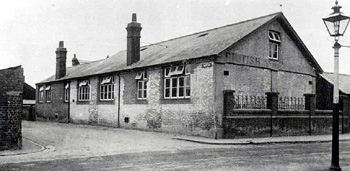
The former Beaudesert British Boys' School in 1913 [Z50/72/21]
1833 Questionnaire
In the country generally the number of schools built continued to grow over the next fifteen years so that by 1833 the government agreed to supplement the work of the two societies, and local benefactors, by making £20,000 per annum available in grants to help build schools. It also prompted another questionnaire to be sent to each parish in England asking for details of local educational provision. The return for Leighton Buzzard also comprised the hamlets of Billington, Eggington, Heath & Reach and Stanbridge. The return for Leighton Buzzard township is broken down thus:
- "Ten or twelve Infant Schools, in which about 150 of both sexes are instructed at the expense of the parents";
- "Eight Daily Schools; one contains 130 males, supported by subscription and small weekly payments from the parents; the other seven contain 49 males and 66 females, educated at the expense of the parents (Three commenced since 1818)";
- "One Day and Sunday School of the Established Church, attended by 30 males daily, and 51 on Sundays. The master is allowed £10 per annum by the Lord of the Manor for instructing 10 gratuitously, and £10 for conducting the Sunday School";
- Three Sunday Schools; one of the Established Church, consists of 70 females; one of Wesleyan Methodists, 130 males and 153 females; and one of the Baptist denomination, 106 males and 138 females, all supported by voluntary contributions".
A total of 19 or 21 day schools and 4 Sunday Schools with quoted numbers totalling around 575 and 648 respectively. The Day School for 130 boys is probably the Lancasterian or British School. The Church of England day school was clearly funded by Leigh's, but probably also by Pulford's Charity and was probably the ancestor of Pulford's School.
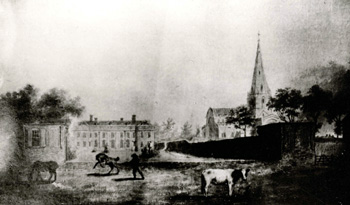
All Saints church and Prebendal House 1797 [P91/28/40]
Church School Enquiry 1846/7
The next national enquiry was in 1846/7 when the Church of England made an enquiry as to all its church schools. This was against the background of a new Whig government which championed secular education and the increasing importance of nonconformists, particularly Wesleyan Methodist, and Roman Catholics in providing schools. The response from Leighton Buzzard was to note that the Sunday School consisted of 286 boys and 316 girls. There was obviously no daily school.
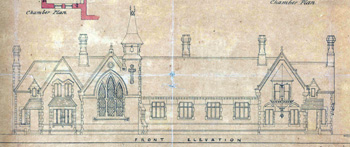
Saint Andrew's School front elevation about 1870 [AD3865/1]
Education Act 1870
The first Education Act was passed in 1870 (it was, more correctly, known as the Elementary Education Act). It was a milestone in the provision of education in Britain demonstrating central government's unequivocal support for education of all classes across the country. It also sought to secularise education by allowing the creation of School Boards. These were groups of representatives, elected by the local ratepayers and the Board had the powers to raise funds to form a local rate to support local education, build and run schools, pay the fees of the poorest children, make local school attendance compulsory between the ages of 5 and 13 and could even support local church schools, though in practice they replaced them, turning them into Board run schools (known as Board Schools). Naturally, and luckily for local historians, the Act required a questionnaire of local schools in 1870. The Leighton Buzzard return listed the Boys' British School (accommodation for 215) in Beaudesert; the Infants' British School (accommodation for 194), in Bassett Road; and the Pulford Church of England Boys' School (accommodation for 104). It was felt that schools for 198 children and 195 girls were needed in the town. "If the British Infant School is used only for children under 7 years of age; if Saint Andrew's Church of England School is completed, and if the Pulford Church of England Girls' School is at once made efficient, by laying down a brick floor and appointing a certificated teacher, the accommodation required will be reduced to the item marked (a)" [a school for 135 girls].
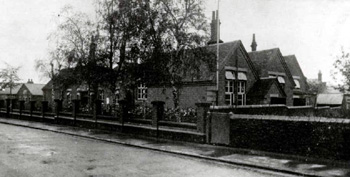
Beaudesert Council Boys School in 1913 [Z50/72/21]
British, then Board Schools 1870 to 1903
One of the fruits of this act was the creation of a School Board in Leighton Buzzard in March 1893. The clerk to the Board was local solicitor David Thomas Willis, whose offices were at 42 High Street. The British Schools thus became Board Schools; Pulford's School and Saint Andrew's School did not become subject to the School Board. In 1894 the old British Boys' School, founded by the Quakers in 1812, became the town's second Board Infants' School and, after enlargement and alteration could accommodate 300. The new Board Boys' School, built in the same year on adjoining land could accommodate 270. The old British Infants' School, built in 1830, in Bassett Road remained and could accommodate 193. In 1873 a British Girls' School had been built on adjoining land in Bassett Road and could also accommodate 193, it became a Board Girls' School.
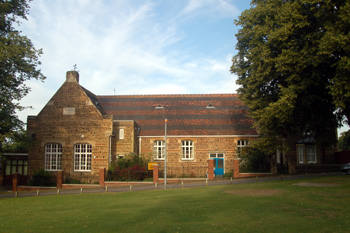
Pulford's Church of England V.A. Lower School June 2008
Public Elementary Schools 1870 to 1903
Saint Andrew's School in North Street was built in 1872, to the design of Frederick Gotto of Leighton Buzzard at a cost of £1,400; it was designed to hold 200. Its counterpart was Pulford's Endowed School which was built in 1884 in Parsonage Close, again to the designs of Frederick Gotto of Leighton Buzzard at a cost of £1,900; it was built to hold 240. It is probably the successor of the Church School mentioned in the 1833 questionnaire. In 1893 the boys from Saint Andrew's were transferred to Pulford's and the girls from Pulford's transferred to Saint Andrew's to create Pulford's Boys' School and Saint Andrew's Girls' School.

W.S.Currie Beaudesert Boys' School headmaster from 1891 shown in 1913[Z50/72/30]
Education Act 1902
A land mark Education Act was passed in 1902, coming into effect in 1903. It disbanded the School Boards and gave day to day running of education to newly formed Local Education Authorities, usually the county council, as in Bedfordshire. The old Board Schools thus became Council Schools whilst the old National, British and other non-Board schools, such as Pulford's and Saint Andrew's, became known as Public Elementary Schools.